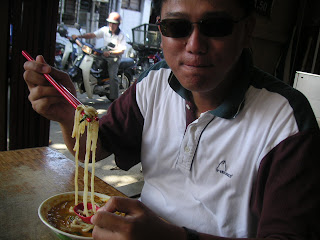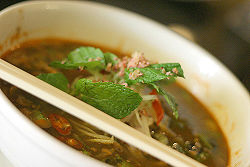Strangely enough I haven't had laksa in a long time so I don't have any pics yet, but I shall endeavour to eat some soon!
Laksa is also a big cause for gastritis and diarrhoea(probably why penangites don't eat it that often!)...so beware of where you eat the laksa from. The ones in Gurney Drive are not bad but are catered more for tourists.
Strangely as a Penangite I don't eat much Laksa, but my friend from KL came so off we went to Balik Pulau for some famous Laksa. The shop we went to has been there since my friend was a kid 20 years ago. It's at the main junction of the Balik Pulau town. According to my friend, there used to be lots of rats and cockroaches around, but thankfully it's all been cleaned up now! It's a simple wooden shop with haphazard tables.
 Now this is the real stuff, a good dollop of thick Hay Koo (Fermented Shrimp Paste) adds the zing to the Laksa. The laksa sauce is super thick and nice to the last drop. This one is the sour Penang Assam Laksa. What can I say, it's unique, the sweet and sour fish based soup really has a bite. Crunchy cucumber slices and tangy pineapple adds to the amazing texture of this simple, classic dish.
Now this is the real stuff, a good dollop of thick Hay Koo (Fermented Shrimp Paste) adds the zing to the Laksa. The laksa sauce is super thick and nice to the last drop. This one is the sour Penang Assam Laksa. What can I say, it's unique, the sweet and sour fish based soup really has a bite. Crunchy cucumber slices and tangy pineapple adds to the amazing texture of this simple, classic dish.
This is the Thai Lemak Laksa which has added coconut milk (santan) in it. It has a different taste, richer yet definitely 100% laksa taste. You really have to try both types to appreciate the difference. One more thing I like are the thick home made rice noodles which have a firm springy bite to it.

And continued to polish off 4 bowls of Laksa by himself....now thats really a classic Penang Hawker fare.
Laksa Wiki
The term laksa is used to describe two different types of noodle soup dishes: curry laksa and assam laksa. Curry laksa refers to noodles served in coconut curry soup, while assam laksa refers to noodles served in sour fish soup. Usually, thick rice noodles are preferred, although thin rice vermicelli also known as bee hoon and any other type of noodles can be used.
Assam laksa
Assam laksa is a sour fish-based soup. Asam is the Malay word for sour, but it is often used as an abbreviation for asam jawa or tamarind, which is commonly used to give the stock its sour flavor. It is also common to use "asam keping" also known as "asam gelugor", dried slices of tamarind fruit, for added sourness. Modern Malay spelling is asam, though the spelling assam is still frequently used.
The main ingredients for assam laksa include shredded fish, normally kembung fish or mackerel, and finely sliced vegetables including cucumber, onions, red chillis, pineapple, lettuce, common mint, "daun kesom" (Vietnamese mint or laksa mint) and pink bunga kantan (ginger buds). Assam laksa is normally served with either thick rice noodles or thin rice noodles (vermicelli). And topped off with "petis udang" or "hae ko", a thick sweet prawn paste.
Variants of assam laksa include:
- Penang laksa, also known as assam laksa from the Malay for tamarind, comes from the Malaysian island of Penang. It is made with mackerel (ikan kembung) soup and its main distinguishing feature is the assam or tamarind which gives the soup a sour taste. The fish is poached and then flaked. Other ingredients that give Penang laksa its distinctive flavour include lemongrass, galangal (lengkuas) and chilli. Typical garnishes include mint, pineapple slices, thinly sliced onion, hε-ko, a thick sweet prawn paste and use of lotus flower. This, and not 'curry mee' is the usual 'laksa' one gets in Penang.
- Johor laksa, from Johor state in southern Malaysia, resembles Penang laksa only in the kind of fish used but differs in everything else. Johor laksa has coconut milk, use 'kerisik', dried prawns, lemon grass, galangal and spices akin to curry. The garnishing comprises slices of onion, beansprouts (taugeh), mint leaves, Vietnamese coriander or 'daun kesum', cucumber and pickled white radish. A dab of shrimp paste (sambal belacan) is placed on the side. Finally, just before eating, freshly squeezed lime juice is sprinkled on the dish. Unlike other laksa versions, Johor laksa has an Italian connection - it uses spaghetti instead of the normal rice noodles or vermicelli.
- Ipoh laksa, from the Malaysian city of Ipoh, is similar to Penang laksa but has a more sour (rather than sweet) taste. The soup stock contains prawn paste.
- Sarawak laksa comes from the town of Kuching in the Malaysian state Sarawak, on the island of Borneo. It has a base of sambal belacan, sour tamarind, garlic, lemon grass and coconut milk, topped with beansprouts, omelette strips, chicken strips, prawns, fresh coriander and optionally lime.
- Perlis laksa is very similar to Penang laksa and only differs in the garnishing used. Sliced boiled eggs are usually added to the dish.
Curry laksa
Curry laksa (in many places referred to simply as “laksa”) is a coconut-based curry soup. The main ingredients for most versions of curry laksa include tofu puffs, fish sticks, shrimp and cockles. Some vendors may sell chicken laksa which uses chicken instead of shrimp. Cockles are usually very commonly used in laksa and most vendors would add them into laksa unless customers request not to have cockles for hygiene reasons. Laksa is commonly served with a spoonful of sambal chilli paste and is traditionally garnished with Vietnamese coriander, or laksa leaf, which is known in Malay as daun kesum. This is usually known as "Curry mee" in Penang rather than curry laksa, due to the different kind of noodles used (yellow mee or bee hoon, as opposed to the thick white laksa noodles). The name "Curry laksa" is more commonly used in Singapore.With the popularity of laksa in Singapore, there are even more 'varieties' of ingredients like lobster laksa, yong tau foo laksa and even plain laksa, just noodles and gravy like the type found on sungei road
Variants of curry laksa include:
- Laksa lemak, also known as nyonya laksa, is a type of laksa with a rich coconut gravy. Lemak is a culinary description in the Malay language which specifically refers to the presence of coconut milk which adds a distinctive richness to a dish. As the name implies, it is made with a rich, slightly sweet and strongly spiced coconut gravy. Laksa lemak is usually made with a fish-based gravy and is heavily influenced by Thai laksa, perhaps to the point that one could say they are one and the same.
- Katong laksa is a variant of laksa lemak from the Katong area of Singapore. In Katong laksa, the noodles are normally cut up into smaller pieces so that the entire dish can be eaten with a spoon alone (that is, without chopsticks or a fork). Katong laksa is a strong contender for the heavily competed title of Singapore's national dish.
- Laksam, a speciality of the Malaysian state of Kelantan, is made with very thick flat white rice flour noodles in a white gravy of boiled fish and coconut milk. Traditionally laksam is eaten with hands rather than with eating utensils due to the gravy's thick consistency.
Summary table
The general differences between curry laksa and assam laksa are as follows:
| Curry Laksa | Assam Laksa |
|---|---|
| Coconut milk is used | No coconut milk used |
| Curry-like soup | Fish paste soup, tastes sour due to tamarind (assam) |
| Except for bean sprouts, no other vegetable is used | Pineapple, shredded cucumber, raw onions may be used |
| Tofu puff is used | No tofu puff used |
| Hard boiled egg may be added | No hard boil egg added |
| Slices of fish cake and either prawns or chicken is used | Fish, normally kembung fish, is used |
| Variants: Laksa lemak, Katong laksa, Nyonya laksa | Variants: Assam Laksa, Penang laksa, Johor laksa |
Laksa is simply referred to or ordered at a restaurant as laksa (curry laksa) or assam laksa. By default, laksa means the standard curry laksa while assam laksa refers to the standard Penang version. If a restaurant serves a non-standard version, the restaurant will qualify the laksa by the version being sold. For example, a restaurant serving Katong laksa will list Katong laksa on the menu.






9 comments:
Oh boy, I couldn't have stumbled upon a much better source of information! This a wonderfully site about hawker fare. Thumbs up!!
Your welcome, it's just a simple site, but I am glad you find it useful!
well written, alot of information, very informative - snapshots
Thanks for the info, it would be useful to me when I'm going to Penang this weekend.
Delicious memories for someone who now lives far away. Anyone have a good authentic recipe?
Yes I must say that this is a wonderfully site about the wonderful Penang hawker fare.
A thousand thanks from the bottom of my heart. Hope I can link this to my blog so that I can always remember all the good stuffs here!
Cheers!
talking about laksa, the best i had in penang is from balik pulau where u get to choose asam laksa or siam laksa. The one at the kopitaim next to the famous penang road 'chendol' is also good. But the best laksa i had is not in Penang, i had one in KL taman bahagia, PJ is the best.
Hi,i just want to share some thought with you ...If you are a Laksa Lover then Probably you may have tried the Rest and now it's time for you to try The BEST Laksa at BESS Kopitiam while you are here in Melaka,Malaysia.
BESS Kopitiam has been choosen as The BEST Laksa outlet in Malaysia year 2009 - 2010 by the General Public in the www.fabfood1malaysia.com
" Reputedly The Best Laksa With Distinguished Taste That Leaves One Craving For More "
Address : 378 - C ,Taman Sin Hoe , Bukit Baru ,75150, Melaka, Malaysia.
H/P : ( 60 ) 017 618 8055
Contact : Ms Tan Peng Boon
Operation Hours : 7.30am - 2pm
Every Thursday is our OFF day
Nyonya Laksa : RM 3.30
Mee Siam : RM 2.80
Nasi Lemak : RM 2.80
BESS Kopitiam Blog : http://besskopitiam888.blogspot.com/
China Press News : http://www.chinapress.com.my/content_new.asp?dt=2010-12-19&sec=mas&art=1219mc35.txt
GPS Coordinates : N 02°13.031' E 102°15.979' or N 02°12.59.6" E102°15.57.9"
Cheers...
The best Assam Laksa in Penang is at Hot & Spicy Cafe, Jalan Air Itam main road, opposite Public Bank Air Itam branch, in front of the old Choong Nam cinema (now a church), just a few doors away from Shell petrol station. It's many times better than Air Itam laksa!!!!!
Just RM3.00 per bowl. It's yummy, yummy, yummy.
The stall also sells yummy Ice Kacang & Ai Yi Bing (Taiwanese jelly dessert)!!!
Post a Comment